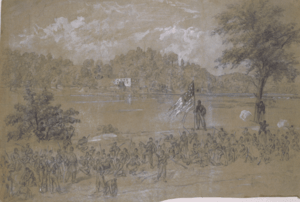Battle of Shepherdstown facts for kids
Quick facts for kids Battle of Shepherdstown |
|||||||
|---|---|---|---|---|---|---|---|
| Part of the American Civil War | |||||||
 Ford near Shepherdstown, on the Potomac. Pickets firing across the river. Alfred R. Waud, artist, Sept. 1862. |
|||||||
|
|||||||
| Belligerents | |||||||
| Commanders and leaders | |||||||
| Fitz John Porter | William N. Pendleton | ||||||
| Units involved | |||||||
| V Corps | Artillery Reserve, A. P. Hill's Light Division | ||||||
| Strength | |||||||
| 2 divisions | 2 divisions | ||||||
| Casualties and losses | |||||||
| 366 (73 killed, 163 wounded, 132 captured/missing) | 307 (36 killed, 267 wounded, 6 captured/missing) | ||||||
The Battle of Shepherdstown, also called the Battle of Boteler's Ford, was a fight during the American Civil War. It happened on September 19 and 20, 1862. This battle was the last of four major fights in the Maryland Campaign.
Contents
Why the Battle Happened
In September 1862, General Robert E. Lee and his Confederate Army of Northern Virginia moved into the North. This was the first time the Confederates invaded Union territory. Lee hoped to get people in Maryland, a border state, to join the Confederacy. He also wanted to convince countries like England and France to see the Confederate states as a real country.
Before Shepherdstown, there had been three other big battles in this campaign. These were the Battle of Harpers Ferry, the Battle of South Mountain, and the very bloody Battle of Antietam. The Battle of Shepherdstown was the final part of this important campaign.
The Battle Begins
After the Battle of Antietam, General Lee's army was tired and needed to retreat. They began crossing the Potomac River at a place called Boteler's Ford. This spot was about one mile east of Shepherdstown.
Brigadier General William N. Pendleton was put in charge of protecting the army's retreat. He was Lee's main artillery officer. This meant he usually sent cannon units to other commanders. But he had never led soldiers in a battle himself.
September 19: The First Day
As the tired Confederate soldiers crossed the river into what is now Jefferson County, West Virginia, Pendleton's artillerymen protected them. They had about 35 cannons set up on the high ground on the south side of the river. However, many of these cannons were old or had a short range. Some could not even reach the Union side of the river. Pendleton also had two small groups of infantry soldiers along the riverbank.
By early afternoon on September 19, the last of Lee's main army had crossed the river. Lee then sent General J.E.B. Stuart's cavalry to another crossing point. Just as the last Confederates were wading ashore, Union General Alfred Pleasonton arrived. He had a small group of Union cavalry with him. His orders were to not follow the Confederates into Virginia unless he saw a great chance to hurt them without losing many of his own men.
Pleasonton saw the Confederate cannons on the bluffs. So, he did not cross the river right away. Instead, he set up 70 cannons on the north side of the Potomac. He then ordered his cannons to fire at the Confederates. The Confederate cannons fired back as best they could.
That same morning, Union General Fitz John Porter's V Corps arrived. He had orders to help Pleasonton and attack the retreating Confederates. As night came, about 500 of Porter's Union soldiers began crossing the Potomac. They attacked Lee's rearguard and managed to capture some of Pendleton's cannons.
Pendleton felt overwhelmed and left his post to find more soldiers. He told Lee that he had lost all his cannons and that Union troops were on the south shore. But he was mistaken. The Union forces had only captured five cannons. While he was gone, the Confederate artillerymen had moved the other cannons to safety.
September 20: The Second Day
Early on the second morning, hundreds more Union troops crossed the Potomac. They joined the 500 soldiers already there. As they moved towards Shepherdstown, they met Confederate soldiers led by General Stonewall Jackson.
Porter realized his men were greatly outnumbered. He ordered them to go back to the Maryland side of the river. But some soldiers could not escape before the Confederates started firing. One group, the 118th Pennsylvania Infantry, was stuck. They were new to fighting and had bad quality muskets that often didn't work. Some had to climb down the cliffs to cross the river while being shot at. This regiment lost 269 soldiers out of 737 men.
For the rest of the day, both sides stayed on their own sides of the Potomac River. The battle ended without a clear winner, a stalemate.
Images for kids


